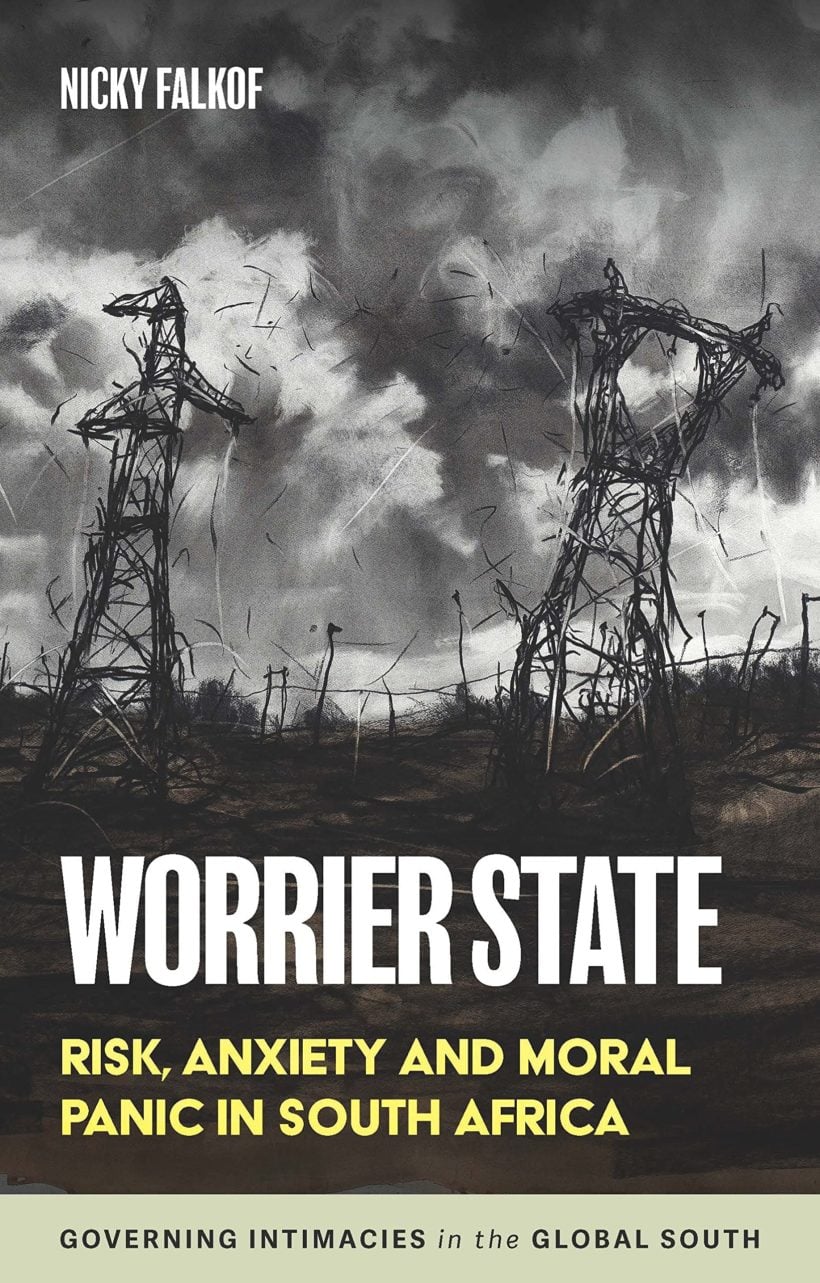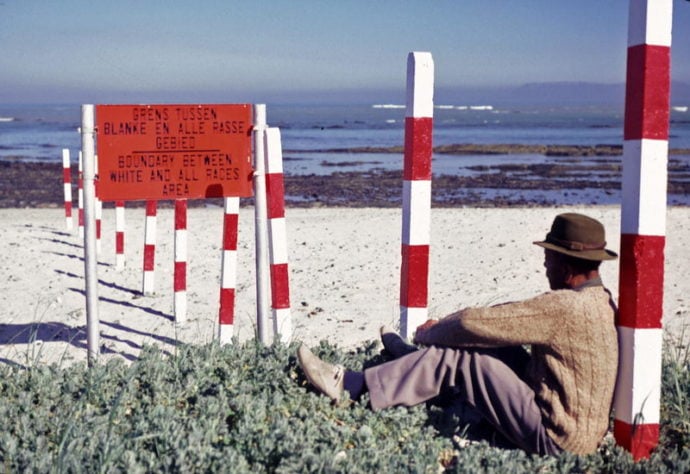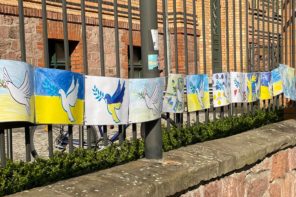Falkof’s book discusses the everyday experiences of fear and moral anxiety in the city of Johannesburg in post-apartheid state South Africa. Drawing on narrative accounts from political protests, mainstream and social media as well as interviews, Falkof juxtaposes publicly propagated motivations for crime, femicide, racist as well as anti-racist political discourses with the structural, historical and socio-economic circumstances that informed such ‘episodes’ in the first place. Falkof’s implicitly activist critique of South African media is socio-political throughout the book: Episodes of fear, anxiety and violence in the country require careful contextualisation when written and circulated widely. Falkof also directs her attention southward by reflecting on meanings of modernity, fear and safety in ‘the more dangerous megacities of the south’ (2022: 19). While these “universal” epistemes are formulated largely in and by developed countries (Mulisa in Falkoff, 2022: 18), their experience in South Africa and other southern cities represents a different kind. Indeed, “[…] the uncertainty that people face on a daily basis as a consequence of corruption, ineffectual government, unreliable infrastructure, inequality, violence and climate change […]” (2022: 19) can hardly be compared to “the speculative anxieties” experienced in the safer societies in the West (idem).

Over the course of four different case studies from the years of 2011 to 2014, Falkof documents how news and social narrative strategies often conceal rather than uncover the socio-economic circumstances that condition experiences of fear and uncertainty in the first place. Chapter 2 deals with the narrative strategies around the phenomenon of ‘white genocide’ and ‘the marketing of minority victims’. Chapter three addresses media reports on two distinct cases of murder, according to which young students were supposedly the victims of various forms of religious and spiritual cult killings. Falkof presents a popular urban legend on so-called ‘plasma gangs’, drugs and crime in Alexandra in chapter four, and in chapter five, juxtaposes narrative communication of ‘safe selves’ to the ones of ‘good selves’ in one of Johannesburg’s comparatively well-off, middle-class suburbs.
Falkof exposes the argumentative strategies that form the basis of allegation for ‘white genocide’, highlighting the groups’ techniques of ‘reverse racism’.
Falkof begins her illustrations by discussing a demonstration of about 160 white Afrikaners who protested against what they and other political activists in the past have called ‘white genocide’. ‘Plaasmoorde’ (Afrikaans for ‘farm murder’), occasional killings of individuals at South Africa’s farms, represent for some the intent to extinguish white Afrikaners in the country. A form of racist rhetoric deployed by the former apartheid state, it is the contemporary diction that explains not only violence, but also unfavourable policy decisions which overall are experienced as outcomes of discrimination by white Afrikaners who affiliate themselves with extreme right political activist groups such as AfriForum and Red October. Falkof exposes the argumentative strategies that form the basis of allegation for ‘white genocide’, highlighting the groups’ techniques of ‘reverse racism’. Illustrating how they, for instance, appropriate the minority category (2022: 53), contest and counter official numbers and meanings of farm murders (2022: 65), and re-circulate refurbished versions of the black ‘communist menace’, Falkof points out the remnant legacy of racialised fear of the former apartheid regime (2022: 69). Falkof’s concern is rooted in the ideological, and fear-inspiring character of the groups’ sociopolitical campaigns: ‘Regardless of how many people in South Africa actually believe that a genocide is occurring, this weaponisation and marketisation of the anxiety that is a constant component of South African whiteness help to keep racist ideas in the forefront of national debate […]’ (2022: 73). The narrative of ‘white genocide’ serves to illustrate contemporary sociopolitical engagements with a not so distant apartheid past. It taps into the white population’s long existing fear of loss of status and power in the country – a historical fear recycled for contemporary political purpose and circumstance.
‘Christian nightmares’, chapter three and the second case of Falkof’s presentation of fear episodes in the country, problematises two different murder cases. In both instances, narratives of satanism inspire what Falkof considers a moral panic, distracting from alternative, less sensational and potentially socio-economic circumstances surrounding and – at least implicitly – informing the murders. By firstly re-visiting ‘the Theologo murder’ thus named after the victim, Falkof works out two divergent narratives that emerged over the course of moving from crime to trial. One, pushed forward by the mainstream media, highlighted the murderers’ supposedly satanic intentions when they set Kirsty Theologo and her friend Bronwyn on fire. The other one, unfolding throughout the court trial, suggested that the violent attack, after which Kristy Theologo died of severe burnings in hospital, occurred against the backdrop of challenging socio-economic living conditions, and was at least partially motivated by romantic jealousy. The ‘Dobsonville killings’, in which Thandeka Moganetsi and Chwayita Rathazayo were killed on their way home from school[FC1] , were equally framed as satanic. In this case, however, court proceedings remained closed to the public and little information was available to the media that could have countered speculations of satanism. Falkof criticises that ‘[w]hile neither of these perspectives placed the murders within patterns of gender-based violence in South Africa, it is nonetheless significant that community members often located the deaths as part of a generalised satanic threat […]’ (2022: 105).
Central concepts of analysis in this chapter are Hannah Arendt’s banality of evil as well as the concept of the spectacle, which, in these instances, resulted from what were clearly femicides committed at the time. Falkof is unsatisfied with the ‘devilish’ evocations in public media reports that these murders were satanic (2022: 82). For her, the actual evil – and banality thereof – resides in the concealing effects of occult narratives in the first place: ‘it is easier to pray for redemption from the devil than to acknowledge the social causes of South African men’s seemingly infinite capacity for violence’ (idem). Even if the latter may represent a somewhat sweeping statement of South African men’s susceptibility for violence in general, Falkof’s dissatisfaction with the analysis of media reports on the one hand, points towards the exceptional effects of satanic beliefs on the other. Falkof also draws attention to Stanley Cohen’s expression of so-called folk devils (2022: 86), again alluding to an apartheid phenomenon that has remained central to public discourse since. Historically, folk devils represent the structural fear of the white Christian [and apartheid] nation, which potentially is endangered by a ‘violent African nationalist revolution’, unruly youth and corrupting foreigners. At times, contemporary myths explaining violence such as the sample cases of femicide in the country as something motivated by the broad category of evil find their origin in racist apartheid history, Falkof suggests.
Falkof’s objective is to draw attention to those aspects of the plasma narrative that distinguish it from stories of ‘normal crime’.
Chapter four on ‘plasma gangs’ stealing plasma televisions in Alexandra township, Johannesburg, addresses fears of burglary amidst working class aspirations for a more affluent life. According to urban legend, gangs would break into homes to take plasma televisions not for their monetary value, but because they contained ingredients to make nyaope, a drug also known as wonga or whoonga (2022: 114). Falkof’s aim is not so much to focus on the case of drug use in this section of her book. Instead, her objective is to draw attention to those aspects of the plasma narrative that distinguish it from stories of ‘normal crime’ (2022: 115); Falkof is interested in urban legend, in other words, and how that very legend informs a sense of fear and anxiety in Alexandra’s communities and beyond. Falkof is eager to invalidate claims to the mysterious consistency of plasma as white powder right at the beginning of the chapter; according to the legend, it is not so much the technology of ‘plasma’ that criminal groups are after, but a small amount of magnesium oxide that ‘coats the display electrodes in a thin layer’ (idem). While they may not be relevant necessarily to understand how urban legend works and travels socially, the facts of what the alleged plasma gangs are actually looking for are central to Falkof’s argument. For Falkof, the urban legend of plasma gangs exemplifies the multiple social problems rampant in Johannesburg’s townships (2022: 117): there is the aspiration to consumption and material wealth on the one hand, and the regularity of theft and crime in the face of drug use and poverty on the other. Altogether, Falkof thus explores the urban myth of plasma gangs by disassembling it into its various narrative components (mainstream and social media, interviews). By highlighting the many factual gaps in public media reporting and reflections of select focus groups, Falkof seeks to emphasise how ‘a tale of gangster criminality, personal danger, magic, violence and fear offered a way to foreground the contradictions that come with living in the South African township, a place that both interpellates residents as aspirational neoliberal citizens and consistently imposes conditions of insecurity upon them’ (2022: 148).
In the final exposition of life in Johannesburg, Falkof moves the focus away from narratives of genocide, murder and crime, towards more subtle and less visible scenes of insecurity and racism. In the comparatively affluent, ‘tree-lined suburban neighbourhood’ of Melville (2022: 151), practices of ‘community-making’ entail ‘paying attention to who and who does not belong, while another part involves a collective performance of altruism […]’ (Falkof, 2022: 152). Ultimately, these appearances are what help local communities distinguish safety from insecurity, those who belong from those who do not. What Falkof observes in the conversations of the online Melville Facebook community group ‘I Love Melville’ (ILM) to which Falkof belongs, is the twofold desire to enact and be seen as virtuous and good (idem). Falkof coins the term of ‘good whiteness’ (2002: 154), a form of South African liberalism defined by ‘a politics of pity that is concerned with the goodness of the giver’ rather than the structural formations of racism and inequality that are a legacy of the apartheid state (idem). Falkof drives home the argument by foregrounding liminal as well as bohemian ways of living in the middle-class suburb. Melville is close to both poorer and more dangerous neighbourhoods of the city as well as to the supposedly more affluent ones; it is also characterised by a comparatively diverse group of residents in terms of race and class (2022: 161). In some ways, Falkof returns to the theme of the second chapter of the book and continues to examine whiteness and white identities in South Africa (2022: 161). Falkof historicises white communities’ continuously anxious behaviours around the need to feel safe against the backdrop of subliminal racist claims to legitimate white culturedness. There is, for instance, the seemingly unspoken belief circulating that cities were made possible through white civilisation, ignoring black migrant labourers’ efforts that helped build them (Nuttal & Mbembe in Falkof, 2022: 161). Somewhat accordingly, fear of difference in the Melville neighbourhood is exercised through disparaging Facebook comments complaining about the homeless ‘window waherrs’ and proto-criminal car guards (2022: 166-167). At the same time, the ILM Facebook group exhibits what Falkof describes as contradictory performances of anti-racism to these very comments (2022: 170). Praiseworthy at first glance, Falkof relies on Ahmed to critically assess such contradictory behaviour: often, written disapproval of racist behaviour lacks efforts for redistribution and action for more structural change (idem). More fundamentally, Falkof takes issue with the striking contradiction between ‘middle-class anxieties about safety and neighbourhood character’ and ‘the urge to be seen doing good’ (2022: 178) when reviewing white middle-class habits of saying good but changing little.
‘Worrier State: Risk, anxiety and moral panic in South Africa’ reads as a radical prompt for South African public media, with a call to look more closely at the anxieties, crimes, murders and politics driven by and in South African communities.
Overall, Falkof’s account reveals what myth may conceal: the socio-political and economic circumstances that constitute the origin of scenes of violence, crime and conflict. ‘Worrier State: Risk, anxiety and moral panic in South Africa’ reads as a radical prompt for South African public media, with a call to look more closely at the anxieties, crimes, murders and politics driven by and in South African communities. Throughout the book, Falkof demonstrates the centrality of public and social media narratives as well as the impact that legend, myth and rumour can have in the collective processing of ‘episodes of fear’, anxiety, racism and violence in Johannesburg. The methodical and detailed reviews of mainstream news coverage, social media conversations and urban legend across four different ‘episodes of fear’ demonstrate the ways in which narrative is appropriated by some white South Africans to twist historical legacies of the apartheid state in favour of their contemporary fears. Falkof’s book equally argues that even if white South African citizens are conscious and aware of racist undertones in their midst, all-encompassing socio-economic change requires more than moral outspokenness when witnessing individual cases of racism and injustice. Even more so, according to Falkof and the scholars referenced, such outspokenness seems riddled with charitable humanitarianism that is concerned primarily with the act-of-help-as-performance-to-be-seen; it often omits the recipient or structural political origin that gave rise to the instance of injustice, racialised inequality and need for help in the first place. One note of omission pertains to the rather scarcely theorised concepts of risk and fear. Clearly, Falkof’s central object of study is discourse describing very concrete instances of violence, crime and racism in the country. Falkof addressed this at the beginning of the book, emphasizing how the four case studies deal with emotion and anxiety in their broadest, social and collective sense. Given the descriptive and astute analysis of South Africa’s zeitgeist, it may have made the argument stronger to clearly connect the theoretical dots between public narrative and collective fear or to not draw on affect theory at all. Ultimately, it remains up to the reader to consider this either a serious analytical shortcoming, or an unnecessary side-note to what is an otherwise succinct critique of South African public and social media discourse: why not more accurately represent the many socio-political and economic challenges that inform actions of crime, violence and racist narrative in the country? The answer to this may certainly be worth another book.
Reference:
Falkof, N. (2022): Worrier State. Risk, anxiety and moral panic in South Africa. Manchester: Manchester University Press.
Featured image by United Nations Photo, courtesy of Flickr.com.








